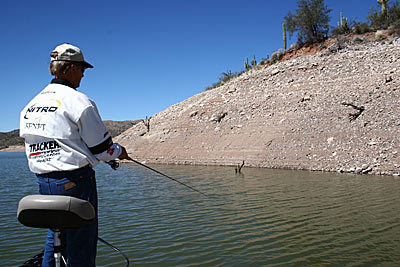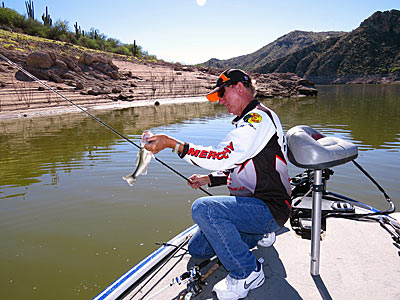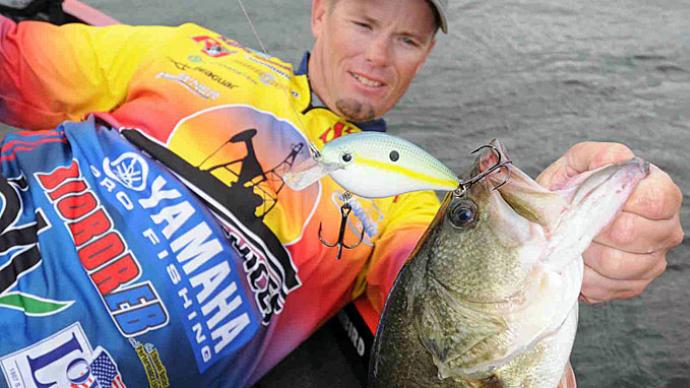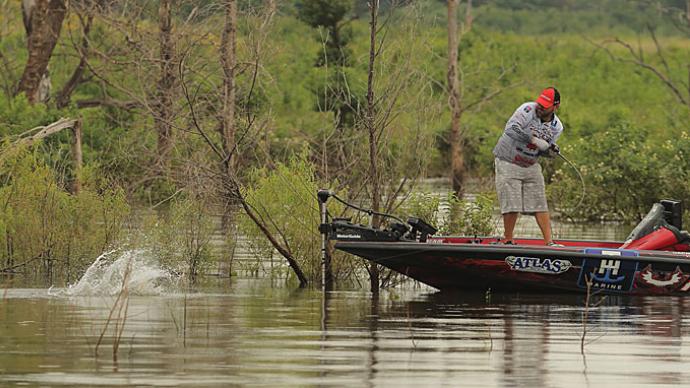
Bass deal with fluctuating water levels all their lives. In tidal waters, the changes are daily occurrences. In large reservoirs, the changes can be slow or abrupt, drastic or slight. Out west, a drought of over a decade has resulted in massive changes in water levels. Even with the day-to-day level being a small percentage of the reservoir's capacity, seasonal changes still affect the behavior of bass. For example, the annual vertical drop is about 100 feet at Lake Pleasant north of Phoenix, Arizona. Oroville in northern California is another reservoir with drastic yearly drops.
“During the summer, Oroville can drop eight or nine inches a day,” California pro Gary Dobyns says. “Sometimes it falls over a foot a day.” This pulls the bass out of the coves, so Dobyns starts his search on points right outside the coves when the water falls. “If the water is falling, they won’t stay in a cove, even right in the middle,” Dobyns explains. “They just get out of there.” Gary doesn’t change how he fishes significantly – just where.
If he can get away with it, Gary will always choose a reaction bait, but at Oroville, he often has to fish for deep fish, which usually means switching to a Roboworm on a dart head or shaky head jig. A Carolina rig is another possibility. “When the water starts falling, the fish suspend a lot, and they get on pilings and trees,” Dobyns adds. “Channels with steep walls can be excellent, too. You can find spots and largemouths in the same places, but the largemouth are usually more cover oriented. Spots suspend more – they have no problem living in open water. If you can find a hump in deep water, it’s a huge deal.”
Watching your graph is critical to finding fish pulled out into open water. If you can find bait, the bass will be nearby. If Gary sees baitfish forty feet deep, he looks for structure at forty feet and fishes there whether he sees fish on it or not. Cover on the structure largely determines what he’ll use on it. If there is a lot of brush or trees, a shaky head worm or a Texas rig is the best bet since both are weedless.

Dobyns likes to rig a Roboworm or a small Yamamoto grub on a dart head with an exposed hook for casting to pilings or structure without brush. “I just let it free-fall and shake it a little,” Gary says, “and I watch the graph.” Gary makes a cast to one side of a piling and lets the lure fall beside it. With the open hook, any fish that bites will be caught. Spotted bass are so aggressive and abundant that he can catch hundreds of them a day just dropping worms and grubs on pilings and other vertical structures.
Arizona angler, Gary Senft, has been fishing desert impoundments for decades, so falling water is something he faces regularly. When the water drops three or four feet, Senft often finds that the fish move on down the bank with it. But sometimes, they change their minds about what they want to eat. If he’s been catching them on crankbaits and the water drops, they may still be five feet deep, but now they are finicky, and he has to go after them with a drop-shot.
Senft will often deal with falling water by throwing a drop-shot rig with a very short leader and working it down the bank almost as quickly as a crankbait. He can put many fish in the boat this way…even when another angler has just gone down the same bank with a spinnerbait or a crankbait. Senft uses Mojo weights because they don’t snag in the rocks and brush as much as other weights, and he uses a variety of Roboworms. “Fish will hang on to a Roboworm forever,” he says. His favorites on any desert reservoir include Morning Dawn and Aaron’s Magic.
In tidal waters, the fish are used to a rhythm of rising and falling water. “In tidal waters, there’s usually a certain time that fish will want to feed,” says Dobyns. “In spring and winter, it’s usually high water, and in summer and fall, it’s low water.” He says that eighty percent of your bites can come in one hour on tidal waters, so chasing the tide is a good strategy. You need to figure out what stage of the tide the fish are biting on, then move so that you’re always fishing that stage. On the delta, for example, if the high water is at Sherman at 9:00, it will be at Stockton around noon. “You can chase the tide for half of the day,” Gary asserts. There is a major and minor tide every day, which changes roughly every six hours. The times change by fifty minutes every day, so it’s essential to have a good tide chart and learn to make the adjustments for locations.

If you decide not to chase the tide, you need to stay in one area and discover how the fish react to the different stages of the tide. Generally, when the tide goes out, and the water falls, they’ll move off shallow grass beds to the edges where the bottom falls off. These areas are easy to see because the grass beds end. Fishing the edges of the grass at low water can be excellent.
Brett Hite is another western pro who is accustomed to lakes with ups and downs. “A lot depends on how fast the water is falling,” says Brett. “If the water is falling fast, they’ll suspend more, and you’ll also find more of them on steeper banks.”
Bass that are suspended in open water often congregate under anything that provides shade. Shade becomes their cover, and Brett has found that he can catch many fish by targeting shade. Many marinas use tires to make breakwaters, which can be hundreds of yards long. The water beneath them may be over a hundred feet deep on some lakes, but bass will still be suspended there.
Brett uses a Vixen right beside the tires to start. The walk-the-dog action of a stick bait like a Vixen will often draw bass up even from deep water, especially in clear water. If that doesn’t work, you can always switch to a spoon or a dart head and send something down to them. When you’re dropping a bait in a hundred feet of water, stopping at 20 or 30 feet, you know it has to be a fish.
The boats and boat houses in the marina provide additional hideouts for suspending bass. A Senko can be your best bet when the bite is particularly tough. Hite throws unweighted Senkos as close to the edges of the boats and breakwaters as he can. A big Senko falls faster than you might think, but it still takes a lot of patience to fish this way. “There could be 500 fish under there,” Hite says. “With that many bass, at least a few have to be hungry.”
Like Dobyns, Brett pays a lot of attention to his graph. Immediately after launching, he examines the graph. “You’ll see a certain depth range where all the clutter is,” he explains. “That’s the activity range, so that’s the range I concentrate on. I look for structure at that depth, and when I fish under the tires, I know I don’t need to let my lures fall any deeper.”
Arizona pro Clifford Pirch has gotten a lot of experience on various lakes since he turned pro. In his home state of Arizona, lakes tend to be very deep, so the fish have plenty of places to go when the water drops. But deep water may only be fifteen feet or so in some lakes, he's fished. “On a shallow lake, when the water starts to drop, it’s like somebody pulled the plug and the fish head right for the drain,” he says. On a lake like this, Clifford looks for the deepest hole nearby. “Say I’m on the Delta, and the tide pulls the water down in a shallow slough,” Clifford says. “I move out to the edge of the grass and flip a worm or a jig.” Grass grows only to a certain depth, so the grass stops when the bottom drops off. This deeper area outside the grass is the first place the fish will gravitate to.
If he decides to down-size and throws a finesse worm on a little jig head, he uses braid but goes to lighter braid and 10-pound fluorocarbon leader. The braided line makes it much easier to set the hook and get the fish back to the boat, even in weeds. He uses a blood knot to join the leader to the braid. “It pays to watch the water level closely,” Cliff adds. “When the water starts to come back up, they move up almost immediately,” Cliff says that bass eat better on a falling tide, but movement, generally, is good because it moves food.
Falling water is something that fish are accustomed to, but anglers may not be. Don’t let a sudden drop throw you for a loop. Just remember that the fish are simply going to move to someplace comfortable and that they are still going to have to eat. If you’ve been on a good pattern, odds are you can find those same fish someplace nearby.
BassResource may receive a portion of revenues if you make a purchase using a link above.




